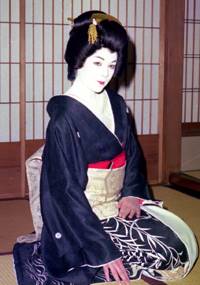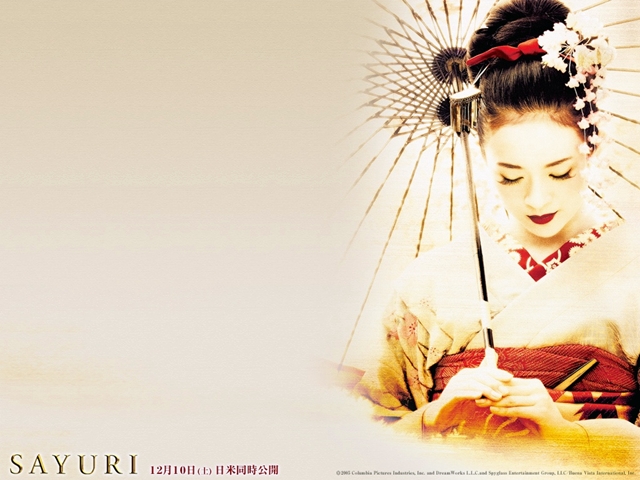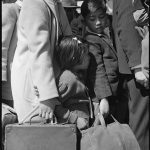By Jae-Ha Kim
Chicago Tribune
December 14, 2005
In both the book “Memoirs of a Geisha” and its film adaptation, women fall into two categories: sexy geisha and conniving dragon ladies, two stereotypes about Asian women that linger today. Already some members of the Asian-American community are worried that the film, which opens locally Friday, may reinforce unflattering images of Asian women as being submissive, sexual objects.
Arthur Golden’s 1997 novel of the same name was an instant best seller, but some readers didn’t like his made-in-the-U.S.A. portrayal of Japan and its women. His book is in part based on his interviews with Mineko Iwasaki, one of Japan’s top geishas during the 1960s and 1970s. Golden’s interpretation of geishas incensed Iwasaki enough that she sued him and wrote her own account, Geisha of Gion: The Memoir of Mineko Iwasaki (Simon & Schuster).
She contended that instead of truthfully representing geishas as cultured, educated women who may or may not provide sexual favors, Golden presented the geisha as a fantasy figure for Western audiences: heavily made up, giggling and available to anyone for the right price.
Set in Japan, the movie and the novel tell the tale of Chiyo. The story begins in 1929, when the pretty 9-year-old girl with unusual gray eyes is sold to work as a servant in a geisha house. The understanding is that she will be trained to be a geisha and work off her “debt”–the money the house spent in procuring her from her family.
Scared, willful and determined to reunite with her older, less attractive sister who was deemed too ugly to be a geisha and sold directly into prostitution, Chiyo tries to escape the life she has been forced to live. Finally, she acquiesces and grows up to be a geisha so beautiful and coveted that her mizuage (virginity) is auctioned off for a record price. By then, she is 16 and has been renamed Sayuri.
The topic of the Western fantasy about Asia and Asian women pops up often in the Asian-American community, whether in academic circles or by anonymous posters venting on Internet message boards. On Amazon.com, “Keiko” writes: “How many times has the West adopted stories from the East, only to reinforce stereotypes and romanticized images of how Asian women should look and behave?” Keiko is referring to “Memoirs of a Geisha,” but just as easily could have been referring to “Shogun” or “The Last Samurai.”
Or as Miho Matsugu, an assistant professor in the department of Chinese and Japanese Studies at Iowa’s Grinnell College says: “Americans have this perception that geishas are a part of everyday life in Japan. They’re not, which is why they’re considered exotic. I was born in Japan and grew up there. I never met a geisha and I don’t know anyone who has. I hear my Japanese women friends talking and they are all tired of hearing about geishas.”
Because many Americans mistakenly view geishas as the Japanese equivalent of prostitutes, Ji-Yeon Yuh, for one, is afraid the film will reinforce stereotypes about Asian women as exotic, submissive and obedient sexually.
“My personal belief is it’s better to have no Asians or Asian-Americans in the movies than to have only this sort of stereotypical and demeaning role,” says Yuh, the director of Asian-American Studies at Northwestern University. “What, really, is so great about being in the movies that any role — even a demeaning one — is better than no role?”
For the three Chinese actresses who star in this film, the roles may have been difficult to pass up. Directed by Academy Award-winner Rob Marshall (“Chicago”) and produced by Steven Spielberg, “Memoirs of a Geisha” will give them visibility outside of Asian cinema.
Ziyi Zhang, who plays Sayuri, is best known in America as the rebellious lead in “Crouching Tiger, Hidden Dragon.” Her “Crouching” co-star, Michelle Yeoh, plays the kindly geisha Mameha. And Gong Li plays Sayuri’s cruel nemesis Hatsumomo.
Of the three actresses, Yeoh–with a James Bond film under her belt, along with co-starring roles in a few Jackie Chan films–has the most name recognition in the United States. But even though critics have hailed her as dynamic on screen, Yeoh has had a difficult time landing roles that aren’t Asian specific.
Nationalities are an issue
To many American moviegoers, it may not matter that the leads are Chinese actresses portraying Japanese geishas. But the nationality of the actresses has become a huge issue in the international community and even has been given ample coverage stateside on CNN and in Time magazine.
“It is a shame that a film with so specific a setting could not have leading ladies steeped in that culture,” film critic Richard Corliss wrote in Time Asia last month. “But there’s a bald fact that is evident to anyone familiar with today’s East Asian films: China is rich in top actresses, and Japan isn’t.”
But Asians and Asian-Americans are asking: Does the average American moviegoer really know a Gong Li from a Devon Aoki?
Japanese starlets such as Kyoko Fukada and Eriko Imai are the right age to play Sayuri, as is American-born Aoki, who’s half Japanese, and whose hazel eyes would have been more convincing than Zhang’s oddly cloudy contact lenses that are meant to convey Sayuri’s gray eyes.
“To me, that statement in Time was absurd,” says Peter Feng, associate professor of women’s studies at the University of Delaware. “It’s like when Spielberg was originally tied to the film [as a director] long before this movie was made. He was going to cast Japanese ballet dancers because he said he couldn’t find any suitable Japanese actresses. What these kinds of statements reveal about the American film industry is that Chinese cinema has a different cultural cachet than Japanese cinema in the West. Putting her in a kimono helps, but Gong Li still looks very Chinese. If an actress’ nationality doesn’t matter, why not use Lucy Liu, who is as bankable as any of the actors in the movie?”
Before making a name for herself on the big screen in the “Charlie’s Angels” films, even American-born Liu played more than her share of stereotypical roles, from a docile Chinese baby-sitter on “ER” to her modern take on the sexually charged Dragon Lady on “Ally McBeal.” She has said in previous interviews that Caucasian men often think Asian women are going to be great in bed, because they harbor “sexual secrets.”
Fitting Hollywood molds
“There is a need in Hollywood to exoticize Asian women,” says L.S. Kim, assistant professor of film and digital media at University of California at Santa Cruz. The stereotype “sells and the public seems to like it. We need more actresses like [Asian-Canadian actress] Sandra Oh [“Sideways” and ABC’s “Grey’s Anatomy”], who are accepted by the audience in roles that aren’t specific to any ethnicity. We need more Asian faces on the screen in all kinds of roles so that we are seen as American first and Asian-Americans second.”
According to experts, it’s not that Asian-Americans don’t want a romanticized story about geishas to be told. It’s that it would be better if it were balanced by other portrayals of women of Asian heritage in modern society.
“Women have always had a difficult time finding good roles in Hollywood, and when you’re an ethnic woman, you’ve got even fewer opportunities,” says Anderson Jones, film critic for CNN Headline News. “There are only so many roles, and Hollywood isn’t that adventurous about trying to find another Lucy Liu.”
Adds Los Angeles-based filmmaker Michelle Hung, whose “Chinese Dumplings” is slated for release in 2006 deals with the universal tale of sibling rivalry: “I would love to see an Asian or Asian-American actress playing a waitress or a cab driver or a drug dealer in today’s society, not only as a geisha at the turn of the century or a peasant in the rice field during feudal times.”
Setting the record straight

Anthropologist and author Liza Dalby is the first American to become a geisha in Japan. She also served as a consultant on the film “Memoirs of a Geisha,” teaching the actresses such skills as the proper way to pour sake and how to glide gracefully while clad in a cumbersome kimono.
Dalby had studied the relevance of geishas in modern Japan while a graduate student at Stanford University. In the mid-1970s, the secretive society of geishas accepted Dalby into the fold because of her fluency in Japanese, her ability to play the shamisen (a three-string, lutelike instrument) and her commitment to learning geisha history. A former assistant professor of anthropology and Japanese studies at the University of Chicago, Dalby, 55, now lives in Berkeley, Calif.
Here she debunks some of the myths surrounding the world of the geisha.
MYTH: Like prostitutes, geishas have sex with their clients.
REALITY: I am always astonished that people seem to think geisha either have sex with customers — making them some sort of prostitute–or that they never do — that they are purely artists. In fact, geisha do have sexual relationships with some of their clients, but they consider that their own business and very much resent being asked about it.
MYTH: Young girls are indentured into the profession.
REALITY: No one is indentured any more. In Kyoto, a girl has to be at least 15 to be accepted for training. She has to be interviewed by the geisha association and the women who run the teahouses. She will spend her first two years proving that she is geisha material by taking lessons in dance, shamisen and comportment. In Tokyo, they tend to start a bit later, when they are in their 20s.
MYTH: All geishas are beautiful.
REALITY: Many are not. Also, the style of beauty they preserve is very traditional, rather out of step with modern notions of what makes a woman a beauty [today].





This is the most unfairly maligned film of the year. Some critics took it upon themselves to be the defenders of Japanese culture (without fully researching their arguments) and, in the process, betrayed their own racism. “The film is inauthentic because the actresses do not wear matronly bouffants,” one said. Riiiiiight. Matronly bouffants are a Western stereotype! But in any case, some of them do and some don’t! THAT’S authenticity. I guess critics wouldn’t know that writing reviews without seeing the film or walking out long before it’s over (some, such as Jeff Wells, do).
Anyway, it’s a fantastic film and more than deserving of multiple Academy award nominations – which it may not get thanks to the fact that so many people decided they wanted to use the film as the sacrificial lamb for a half-baked debate about international politics, rather consider that pan-Asian casting for major roles is NOTHING new (it’s true of House of Flying Daggers, The Joy Luck Club and even Crouching Tiger) and that this film’s production might represent international cooperation at its best.
Look out for Gong Li and Youki Kudoh in RICHLY developed supporting roles. The supporting males, while obviously not as well developed since they spend less time in the geisha quarters, still give incredible performances. Ken Watanabe was excellent, but I particularly enjoyed the performance of the actor playing Nobu. Oprah is right about the sets and costumes; they (amongst other things) make you want to savor every moment of the film. Some people have argued that the brilliant colors make it seem like some sort of Orientalist fantasy. Truth is that this would only be the case if we saw a departure from a more sedate West to a flamboyant East; instead, the film opens in a rather sedate part of Japan and then takes us to the more colorful geisha district (which introduces this fascinating paradox of great suffering in a milieu of tremendous beauty). We know from Chicago that it’s simply Rob Marshall’s aesthetic to make everything the height of beauty, even if it’s a slum. God forbid ENTERTAINMENT CIRCLES should be presented as visually spectacular! The film is by turns funny, moving and, yes, thrilling. Gasps in the audience for the film’s third act gave way to sniffles. Ziyi Zhang really managed any language difficulties well; her face has this ripple effect when she’s emoting. It’s stunning to behold. If I were voting for the Oscars, I’d definitely give her a nomination at the very least. And homegirl can dance, too! Her performance and the film itself are not boring at all; audience members laughed when she was trying to be funny and sighed when she was suffering. IMO, too much happens in the film for it to get boring; there’s a strong balance between the rivalries, the details about geisha entertainment and the romance. In the final scene, it all comes full circle. I won’t tell you how. See for yourself.
My #1 film of the year. Brokeback Mountain, Chronicles of Narnia, Howl’s Moving Castle, King Kong and Grizzly Man aren’t far behind.
Apparently this spammer copied and pasted that rant directly from imdb.com: http://www.imdb.com/title/tt0397535/reviews-42